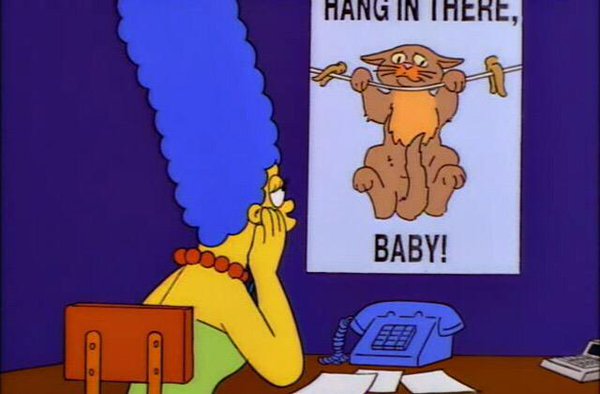I think motivational posters (see picture above) are a little bit of a throwback/relic to the working environments of the 1960s, but the spirit of them lives on today. Typically, this happens in memes that people send around on work email threads, oftentimes on Friday afternoons. (Someday, in the distant future, people may pull their head out of their posterior about how to most effectively use Friday afternoons at work. That day is not this Friday.)
When I talk about “motivational posters,” then, what I mean is this: we have an entire industry around how to motivate others. Frankly, most of the advice is trite bullshit cooked up by thought leaders. I’m not necessarily knocking this, either: as you rise up a management chain, you are typically most beholden to growth. A lot of people can’t see the difference between “individuals growing” (i.e. being motivated) and “the bottom line growing” (i.e. “I get a fatter bonus”). This is just one of the ways that management is not intuitive for a lot who become managers.
Same deal: you know how executives love to mention their “core values” in speeches, then often never act on a single one of them? That’s another new-school version of old-school motivational posters. Tack something on the wall. Simply because it’s there, hope it seeps into the consciousness of people who work for you. If it doesn’t, oh well. So long as the revenue growth is there!
[Tweet “The way we motivate employees is such a tire fire at most companies.”]
Motivational posters and buzzword-laden core value statements do nothing to actually motivate people or get a company growth. But how does that happen, then?
Some quick research on soft skills and growth
Most people have a hard time linking “soft skills” (i.e. “listening”) to “big money,” so let’s try that first:
- A compassionate work culture can lead to more profits
- So can a more empathetic culture
- … and so can a culture with better communication
Alright. There’s three examples, with research. It’s not about motivational posters, memes, or sayings. It’s actually about the same core skills you need to use in human relationships. We over-complicate that at work way too much.
A quick motivation quote from the Chief Creative of Squarespace
Millions of users. Platform adored by creative types. The CCO says:
If you truly want to inspire people, you have to be more of a psychologist than a taskmaster. “Leadership is all about understanding people—learning what makes every member of your team tick. It’s fine and dandy to set a North Star that anyone can march to, but ultimately people are unique. Some want to be inspired, some need tough love. Your job is to pull on all these levers to find the best ways to get your team to do the best work of their lives.”
“Setting a North Star that anyone can march to” is what I call “target-hitting,” and usually that just burns people out — it doesn’t motivate them. This is why stuff like “stretch assignments” is mostly BS, but real human growth is not.
Burn all the motivational posters
You want to know how to motivate others? Here are a few basic ideas:
- Respect them
- Recognize them
- Show them you’re invested in them
- Give ’em some autonomy
- Understand that money isn’t everything
- Stop drowning everything in process
- Let them be themselves
Not rocket science. And hey, you’re saving money on these motivational posters and “value-driven consultants,” yea?
Corporations and moral norms
While this stuff is logical, the reason it usually doesn’t happen is that companies are not beholden to moral norms. Most companies exist to please a specific set of stakeholders — and that’s it. Corporations honestly only began as a way to squash the peer-to-peer networks of the Middle Ages. It’s all about funneling assets (namely $$$) back to the top. We’re seeing the same stuff now with tech growth and the coming waves of automation. Corporations don’t care if your mom has Alzheimer’s. That shit does not matter if they can make an additional penny leaving you out in the cold.
This is often why stuff like “core values steeped in buzzwords” happens. Everyone running a company secretly knows the score: people don’t matter, process/product/growth does. But you can’t admit that because (a) it sounds bad and (b) the robots aren’t totally ready yet. So instead you meow about your “vision-driven, people-first culture,” and then create processes designed to help managers hide from people. (See: once-a-year performance reviews.)
It’s all a giant game at most places, unfortunately. The top and some of the middle makes the money, and the rest of us toil. Want feedback? No time! 12:30 standup on Q2 metrics! Want to be motivated? Can’t be bothered! Urgent client needs!
This is the motivational posters culture we’ve created — do the laziest thing possible and expect some result — but it’s not the right one to drive true growth.
